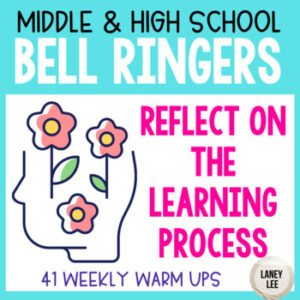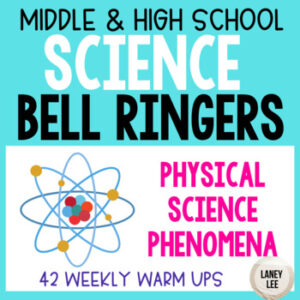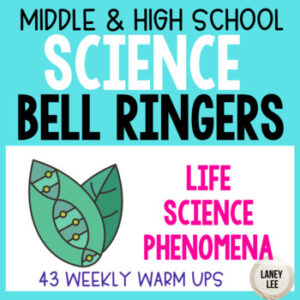
Laney Lee
Welcome to middle school! As we prepare to end one school year, many new middle grade teachers are already looking ahead to the next. That’s great! Summer is the perfect opportunity to spend a little bit of time preparing for your first year in a middle school position – (mixed in with a healthy dose of relaxation, of course!) So whether you are a first-year teacher just out of school or you’ve taught other grade levels in the past are now making the switch to middle school, here is some of my best advice and tips for new middle school teachers.
If you’ve chosen to focus your teaching career on working with middle school students, you’ve likely received a wide variety of feedback on that choice. Things like:
It’s true. Middle school teaching isn’t for the faint of heart and it DOES take a special kind of person to spend an entire year with a classroom full of pubescent twelve-year old’s. That being said, there are so many wonderful aspects of working with this particular age group. When you take the time to truly understand the nuances of the students in your classroom and work to create learning environment built on mutual respect and personal connection, I truly believe you will have a great time with your middle school students!
A great piece of advice I received as a new teacher was: “Expect to teach them EVERYTHING.” It can be tempting to expect a higher level of skill and competency with certain things than our students are actually capable of. After all, they’ve been doing this whole “school thing” for a while, right?
Well…middle school students actually still need a good bit support when it comes to learning procedures within the classroom. They thrive on structure and consistency. As someone who specifically teaches science class, I found this to be true.
This is especially true if you will be teaching sixth graders, but even for those teaching older students who “should have learned this last year” — just know, they will probably need a refresh in the first days of school, as well as several additional times throughout the year when they seem to have “forgotten” how to function in a middle school classroom.
There’s no getting around it…middle schoolers are downright goofy. They make silly noises, enjoy watching their teachers do and say ridiculous things, and think there’s nothing funnier than a placed fart joke. You can either resist this goofiness, or you can choose to use it to your advantage! I recommend the later. Do what you can to incorporate some goofiness into your lesson plans. Not only will this grab your students’ attention, it will help with building relationships with your students.
One of the most important and impactful tips for new middle school teachers is to be consistent with your expectations. I truly cannot stress this one enough! As new teachers, you’re likely still figuring out what your classroom rules, routines, and expectations should be. That’s okay! Trial and error is part of the game. That being said, constantly changing the way you choose to run your own classroom will not only be confusing, it will likely result in unwanted behavior problems on a daily basis.
Middle schoolers are going to test the limits…Honestly, can you blame them?
If you’re unsure of where to start when it comes to establishing consistent expectations in your classroom, I’ve got you covered. I’ve spent my years of teaching working to develop good classroom management practices that will help you start the year off on the right foot.
I’m a strong believer that if you start with order, structure, and consistency, you’ll have more time for fun and flexibility. If you talk with any veteran teacher, they’re likely to something along the same lines. This is why I have a well-planned and communicated procedure for just about everything we do within the classroom. I’ve found that having plans for the way things ought to be done is the best way to maximize our instructional time and cut down on behavioral issues. In essence, it helps both my students and myself have a more peaceful and enjoyable class period.
I’ve never been a fan of letting students choose their own seats. There, I said it! Personally, I think it leads to chaos in the classroom. Middle schoolers rarely choose a seat that is actually the best choice for their learning. In fact, they do what anyone would do…opt to sit near their friends, which typically is the most distracting seat they could choose.
By assigning seats, I am able to cut distractions in the classroom. This also allows me to think strategically about table groups, making sure each group has a balance of personalities and/or ability levels (depending on my goals for group work.)
I make it a goal to call on each of my students multiple times during each class period. This helps ensure that every student is engage and participating, rather than simply hearing from a few extra motivated voices. It also helps keep my students on task and focused because they know they could be called on to answer a question at any moment.
Keep a class roster list in front of your during class discussions. Each time you call on a student, put a tally mark next to their name. This will help you keep track of who has already been called on, and who needs to be given the chance to share.
Bell ringer activities are short and engaging tasks that students complete first thing at the beginning of your class time. They are typically quick activities that last anywhere from five to ten minutes, and can be completed independently. Not only do these tasks get students thinking about their subject matter, they’re also an excellent classroom management strategy.
Imagine having 25-30 middle school students in your room with NOTHING to do. Trust me…it’s a total circus. A little bit of daily bell work is an easy way to cut down on the pre-teen chaos and start class off on the right note.






“I lost my notebook.”
“I left it at home.”
“It’s in my locker.”
It only took a few times of hearing statements like these to realize that our interactive notebooks are best kept in my classroom. If they stay in the room, there’s zero chance of students forgetting or losing this valuable resource. It also means students truly don’t have a good excuse for not being prepared for class.
Every classroom needs a solid system for turning in drawers. For me, I’ve found the simplest way to organize the assignment my students submit (those that aren’t turned in digitally) is to have turn in drawers with a separate color for each class period. Students learn quickly which color corresponds with their class period and are responsible for making sure their work is in the correct bin.
Continue the discussion in my Facebook Group for Middle School Science Teachers or my Classroom Management Facebook Group.
Or get free science resources delivered straight to your inbox by signing up for my newsletter! I promise to never be spammy. I’m just a regular teacher who likes helping teachers teach and students learn.